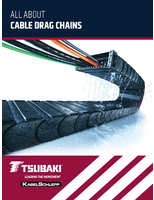Conference seeks cross-sector anti-counterfeiting solutions.
Press Release Summary:
In effort to help find cross-sector anti-counterfeiting solutions, ANSI convened conference titled "Crossing Borders and Sectors: Exploring Robust Anti-Counterfeiting Solutions," as part of ANSI's annual World Standards Week events. Representing everything from consumer goods and pharmaceuticals to aerospace electronics and certification marks, attendees agreed that taking stronger action and increasing cooperation and communication are key to reducing counterfeiting in U.S. and abroad.
Original Press Release:
ANSI Conference Seeks Cross-Sector Anti-Counterfeiting Solutions
Counterfeit merchandise has led to numerous risks for consumers worldwide, from significant health and safety concerns over counterfeit life-saving drugs, to flammable electrical devices, to tremendous financial loss for U.S. businesses, government, and individuals. With up to $250 billion in business losses and 750,000 American jobs at stake each year, it's clear that the illegal and unethical actions of counterfeiters have led to economic instability and decreased quality of life for people all over the world.
In an effort to help find cross-sector solutions to this global challenge, the American National Standards Institute (ANSI) convened a conference on September 22, 2010, Crossing Borders and Sectors: Exploring Robust Anti-Counterfeiting Solutions, as part of ANSI's annual World Standards Week events in Arlington, VA.
"The rapid growth and sophisticated organization of counterfeiting operations is increasingly threatening legitimate business and the health and safety of millions of people. The issue crosses all borders, and it reaches from the highest levels of government and industry to the average consumer on the street," said S. Joe Bhatia, ANSI president and CEO, in his introductory remarks. "We must work in collaboration to develop the public-private partnership needed to identify and address counterfeiting health and safety issues."
High-level speakers from government, industry, international law enforcement, the military, and academia led attendees in collaborative discussions of effective solutions for addressing health and safety concerns and significantly reducing the massive economic impact of counterfeiting worldwide. Representing everything from consumer goods and pharmaceuticals to aerospace electronics and certification marks, attendees agreed that taking stronger action and increasing cooperation and communication are key to reducing counterfeiting in the U.S. and abroad.
The event began with keynote remarks from Lynne G. Beresford, commissioner of trademarks for the U.S. Patent and Trademark Office (USPTO). Ms. Beresford spoke on the USPTO's anti-counterfeiting initiatives, including www.stopfakes.gov, a website that provides toolkits for protecting trademarks, intellectual property rights (IPR), and goods in other countries. The USPTO has developed this and other programs to help small businesses take proactive steps against counterfeiters, and all affected stakeholders are strongly encouraged to take advantage of them.
A panel discussion then addressed the ways that counterfeiting impacts every industry sector. Speakers discussed issues related to consumer goods, aerospace electronics, food ingredients and pharmaceuticals, and IPR. Brian Monks of Underwriters Laboratories Inc. (UL) emphasized that counterfeiting focuses on low cost and passable appearance only, leading to products that may look real but are low quality and can be dangerous. He stressed that anything of value can and likely will be counterfeited, compromising the safety of the public in countless ways.
It is often said that counterfeiting is a victimless crime, and that the purchase of a cheap purse or DVD on a corner means nothing when the consumer can plainly see that the goods are of low quality. But what the consumer doesn't recognize, according to Mike O'Neil of the North American Security Products Association, is that the profits raised by these "victimless" purchases are used to perpetrate very real and very alarming crimes. In a slide from his presentation, Mr. O'Neil showed the names of several prominent criminal organizations alongside their known illegal activities, including human smuggling, narcotics trafficking, and contract killing. The two most prominent activities on the list - film piracy and counterfeiting - are used to finance the other activities because they are easy ways to raise cash without too much risk.
Panelists Don Davidson of the U.S. Department of Defense, Markus Lipp of U.S. Pharmacopeia, and Edward Gibson of PricewaterhouseCoopers furthered these points and outlined their organizations' initiatives in counteracting the effects of counterfeiting on consumer safety and the U.S. economy.
John Newton of INTERPOL outlined his organization's Certification Against Industry Counterfeiting (CAIC) initiative, which works with countries where counterfeit products originate to find solutions. He emphasized the importance of presenting source countries with evidence of how counterfeiting is as harmful for them as it is for the U.S., and of providing them with concrete help in the fight. Partnership and collaboration between multiple countries, customs, law enforcement, and industries are needed to establish effective measures, and INTERPOL is active in facilitating those solutions.
Brad Botwin of the Office of Technology Evaluation at the U.S. Department of Commerce (DOC) and Ric Loeslein of the Naval Air Systems Command led the next panel discussion. They outlined an initiative when the Navy asked the DOC to develop a report on counterfeiting, including findings of the scope of the problem and best practices. The report found that a lack of dialogue across the supply chain led to an increased use of counterfeit products. People at each step of the chain thought that products had already been examined for counterfeits, but it wasn't happening anywhere. Better communication and training, shared lists of trusted - and untrusted - suppliers, and ensured destruction of counterfeit goods were named as best practices to reduce counterfeiting.
The event concluded with an open question and answer session led by William G. Raisch of the International Center for Enterprise Preparedness at New York University. Attendees discussed their views on how often and where in the supply chain checks for counterfeit products should be made. The need for greater outreach and education was emphasized, particularly with regard to smaller businesses. Another concern was that companies often hesitate to engage authorities when they discover counterfeiting for fear of getting a bad name. Participants suggested that industry organizations may help to mitigate this by bringing many companies together to discuss the problem, collaborate on solutions, and address issues on the entire industry's behalf.
ANSI is now compiling these and other key findings into a "best practices" action guide that will provide organizations with concrete steps to assess and address counterfeiting across industry sectors. Once completed, the guide will be freely available at www.ansi.org.
Proceedings and presentations from the event are available here. To view photos, click here. For more information on World Standards Week, visit www.ansi.org/wsweek.




